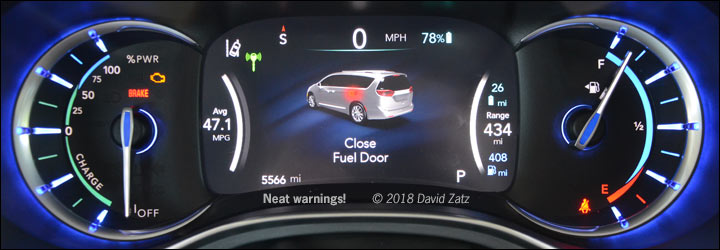
For over half a century, the United States and Canada have freely moved cars and parts across the border. The Auto Pact, taken for granted from the 1960s into 2017, ended the practice of making nearly every model sold in Canada, in Canada — which was quite expensive for American automakers, who then as now dominated Canadian sales, and for Canadian buyers.
Today, as one example, all Chrysler minivans and large cars are made in two plants in Canada, which used to produce the full range of Chrysler, Dodge, and Plymouth cars, trucks, and vans — in very small quantities. While most of the output of these plants feeds American needs, Canadians buy all their Ram pickups and Jeeps from United States-based plants.

The Pacifica pictured here, in its own gauge cluster, is made exclusively in Canada and sent, tariff-free, to the United States. In return, the United States sends Ram pickups and Jeeps to Canada, tariff-free.
Shortly after Donald Trump was elected to the presidency of the United States, he demanded that NAFTA be renegotiated, complaining about Canadian treatment of some American dairy farmers. NAFTA has now, as Trump promised, been scrapped, in favor of a renamed version — the United States-Mexico-Canada Agreement (USMCA), which is slightly longer in title and puts the United States first. The offending dairy provision on the Canadian side, which affected a single province, has been removed.
NAFTA’s dispute resolution process, which had been targeted by Trump for deletion, remains in place, so Canada has a mode of appeal if Trump places tariffs on Canadian automotive goods. The primary U.S. gain was with Mexico, which agreed that 40-45% of a car must be built with $16/hour+ labor to be duty free. Critics have claimed that this provision will be relatively easy to bypass.
The pact has yet to be endorsed by the U.S. Congress.
While Canada is the world’s largest importer of American goods, and the United States takes up 75% of what Canada exports, the northern nation has recently been signing free trade agreements with Asian and European entities, to diversity its import and export markets. The time (and presidential insults) leading up to the NAFTA rewrite/rename may have changed the historical trade ties between Canada and the United States somewhat, as Canada’s exploration of new markets will bear fruit over the coming years.

David Zatz has been writing about cars and trucks since the early 1990s, including books on the Dodge Viper, classic Jeeps, and Chrysler minivans. He also writes on organizational development and business at toolpack.com and covers Mac statistics software at macstats.org. David has been quoted by the New York Times, the Daily Telegraph, the Detroit News, and USA Today.

Leave a Reply